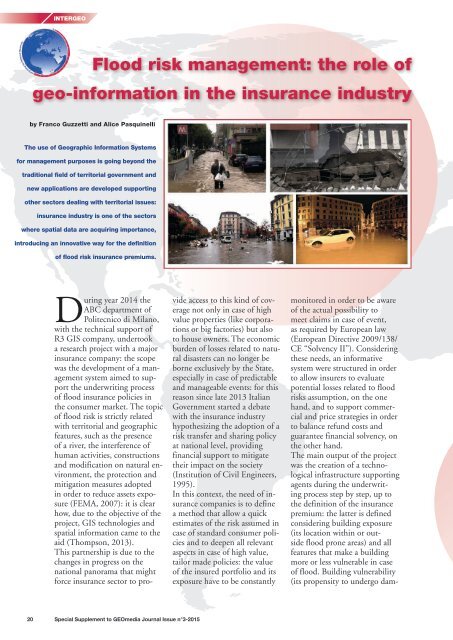GEOmedia_3_2015_special_INTERGEO
Create successful ePaper yourself
Turn your PDF publications into a flip-book with our unique Google optimized e-Paper software.
<strong>INTERGEO</strong><br />
Flood risk management: the role of<br />
geo-information in the insurance industry<br />
by Franco Guzzetti and Alice Pasquinelli<br />
The use of Geographic Information Systems<br />
for management purposes is going beyond the<br />
traditional field of territorial government and<br />
new applications are developed supporting<br />
other sectors dealing with territorial issues:<br />
insurance industry is one of the sectors<br />
where spatial data are acquiring importance,<br />
introducing an innovative way for the definition<br />
of flood risk insurance premiums.<br />
During year 2014 the<br />
ABC department of<br />
Politecnico di Milano,<br />
with the technical support of<br />
R3 GIS company, undertook<br />
a research project with a major<br />
insurance company: the scope<br />
was the development of a management<br />
system aimed to support<br />
the underwriting process<br />
of flood insurance policies in<br />
the consumer market. The topic<br />
of flood risk is strictly related<br />
with territorial and geographic<br />
features, such as the presence<br />
of a river, the interference of<br />
human activities, constructions<br />
and modification on natural environment,<br />
the protection and<br />
mitigation measures adopted<br />
in order to reduce assets exposure<br />
(FEMA, 2007): it is clear<br />
how, due to the objective of the<br />
project, GIS technologies and<br />
spatial information came to the<br />
aid (Thompson, 2013).<br />
This partnership is due to the<br />
changes in progress on the<br />
national panorama that might<br />
force insurance sector to provide<br />
access to this kind of coverage<br />
not only in case of high<br />
value properties (like corporations<br />
or big factories) but also<br />
to house owners. The economic<br />
burden of losses related to natural<br />
disasters can no longer be<br />
borne exclusively by the State,<br />
e<strong>special</strong>ly in case of predictable<br />
and manageable events: for this<br />
reason since late 2013 Italian<br />
Government started a debate<br />
with the insurance industry<br />
hypothesizing the adoption of a<br />
risk transfer and sharing policy<br />
at national level, providing<br />
financial support to mitigate<br />
their impact on the society<br />
(Institution of Civil Engineers,<br />
1995).<br />
In this context, the need of insurance<br />
companies is to define<br />
a method that allow a quick<br />
estimates of the risk assumed in<br />
case of standard consumer policies<br />
and to deepen all relevant<br />
aspects in case of high value,<br />
tailor made policies: the value<br />
of the insured portfolio and its<br />
exposure have to be constantly<br />
monitored in order to be aware<br />
of the actual possibility to<br />
meet claims in case of event,<br />
as required by European law<br />
(European Directive 2009/138/<br />
CE “Solvency II”). Considering<br />
these needs, an informative<br />
system were structured in order<br />
to allow insurers to evaluate<br />
potential losses related to flood<br />
risks assumption, on the one<br />
hand, and to support commercial<br />
and price strategies in order<br />
to balance refund costs and<br />
guarantee financial solvency, on<br />
the other hand.<br />
The main output of the project<br />
was the creation of a technological<br />
infrastructure supporting<br />
agents during the underwriting<br />
process step by step, up to<br />
the definition of the insurance<br />
premium: the latter is defined<br />
considering building exposure<br />
(its location within or outside<br />
flood prone areas) and all<br />
features that make a building<br />
more or less vulnerable in case<br />
of flood. Building vulnerability<br />
(its propensity to undergo dam-<br />
20 Special Supplement to <strong>GEOmedia</strong> Journal Issue n°3-<strong>2015</strong>


















